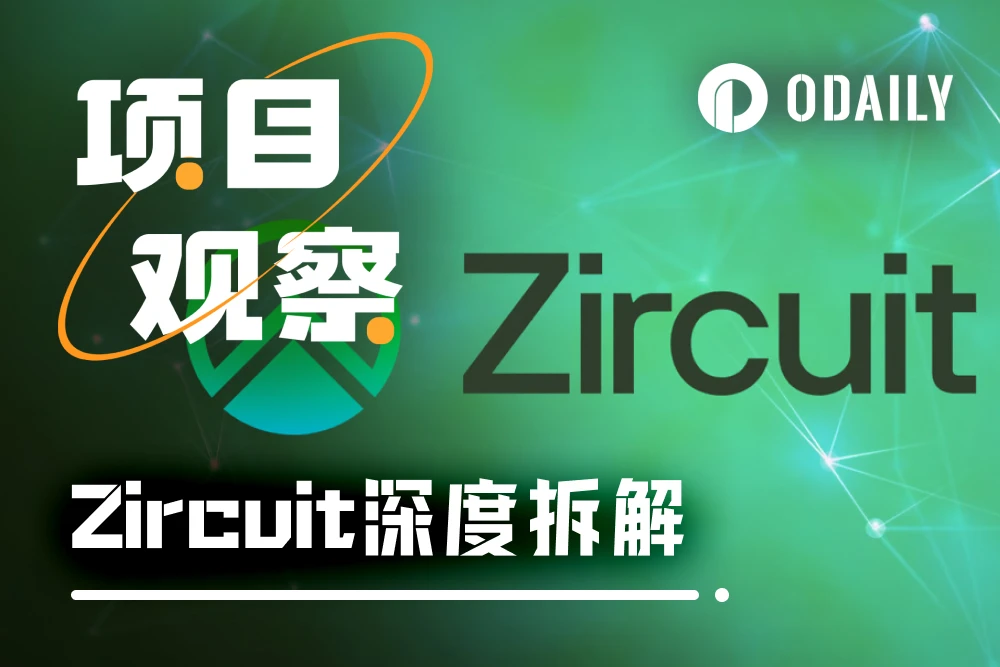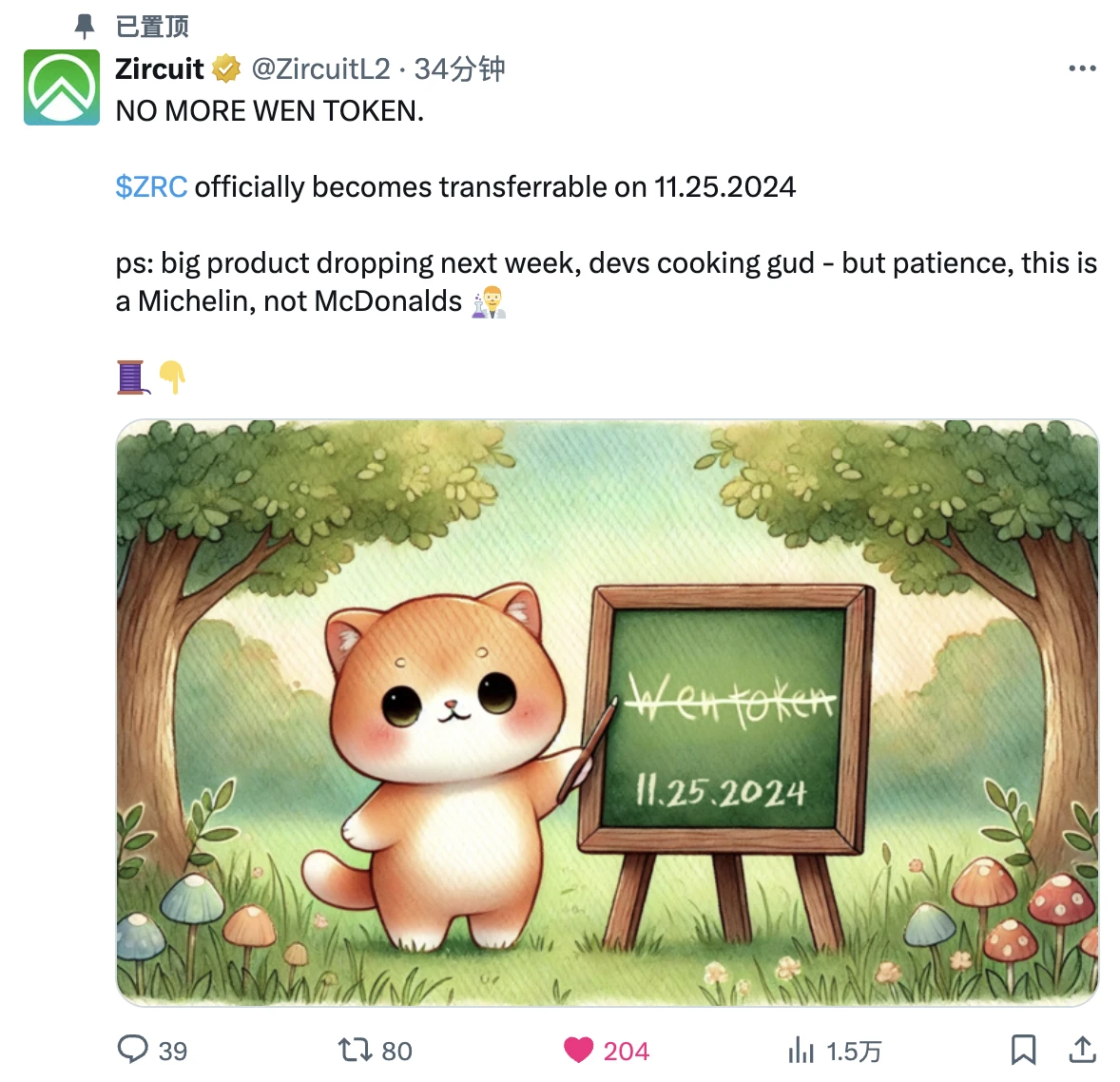
The industry's first ZK Rollup network integrating AI concepts, Zircuit, has recently been very active, with a total value locked (TVL) exceeding $2 billion.
On October 25, Catizen announced that Zircuit became the first project to launch on its Launchpool product.
On October 31, Zircuit, in collaboration with Binance Web3 Wallet, launched a gas subsidy campaign, offering gas refunds to all users who bridge and stake ETH through the Binance Web3 Wallet client to Zircuit.
On November 1, Zircuit announced the launch of the Fairdrop airdrop campaign, which will distribute 2% of ZRC tokens to over 200,000 eligible EIGEN holders and stakers to incentivize early supporters of the restaking vision.
In just a few days, Zircuit's governance token ZRC was listed on pre-market trading platforms of major exchanges such as Bitget, Gate, and Bybit. Real-time data shows that the ZRC token is currently priced at $0.11 in the Bybit pre-market (with Bitget at $0.1 and Gate at $0.082), corresponding to a valuation of up to $1.1 billion based on a total supply of 10 billion tokens.
On November 22, Zircuit officially announced that the transfer restrictions on ZRC would be lifted on November 25, at which point ZRC will officially enter circulation.

Three Unique Advantages Helping Zircuit Stand Out
In July of this year, Zircuit completed a new round of financing, with participation from Binance Labs, Mirana Ventures, Amber Group, Selini, Robot Ventures, Nomad Capital, Borderless Capital, and angel investors from projects such as Renzo, Etherfi, Pendle, Parallel, LayerZero, Axelar, F2Pool, Nonce, KelpDAO, ETHGlobal, and Maelstrom.
Zircuit's design cleverly integrates multiple concepts such as ZK, AI, and Restaking, which can lead to some confusion among users when trying to position Zircuit. If we were to explain the project's positioning in one sentence, it might be — Zircuit is a Layer2 network that combines the advantages of Optimistic Rollup and ZK Rollup, leveraging AI to enhance network security while utilizing staking and restaking narratives to invigorate ecological liquidity.
This positioning outlines Zircuit's three unique advantages, with the key terms being "OP + ZK," "AI," and "Liquidity."
Key Term One: OP + ZK
The term "OP + ZK" refers to Zircuit's adoption of a hybrid architecture combining Optimistic Rollup and ZK Rollup. The construction of a Rollup network involves various components such as sequencer data publishing, smart contracts, cross-chain bridges, and execution layers. To develop more efficiently, Zircuit utilized the most mainstream and practically tested Rollup development framework, OP Stack. However, since OP Stack only supports the construction of Optimistic Rollups, Zircuit removed all components related to the Optimistic model from this framework and replaced them with ZK components.
As a result, while Zircuit is fundamentally a hybrid architecture, from the user's experience, it is entirely a ZK Rollup. The design of the hybrid architecture ensures that Zircuit can complete network construction in a shorter time and in a more secure manner, while also allowing Zircuit to overcome the functional limitations of OP Stack and directly realize the benefits of ZK Rollup. Additionally, Zircuit's compatibility with OP Stack ensures that the network can smoothly support future Ethereum upgrades, helping Zircuit keep pace with the development of the broader Ethereum ecosystem.
Key Term Two: AI
Compared to all current Layer2 networks, Zircuit's biggest feature is that it is the only Layer2 that effectively integrates AI mechanisms into the operational layer of the network. Specifically, Zircuit has added an SLS (Sequencer-Level Security) system at the sequencer level, which includes an AI evaluation module that uses transaction data from all EVM-compatible chains as training material to autonomously detect and identify transactions with malicious intent.
When a transaction is initiated on the Zircuit network, the AI evaluation module of the SLS system automatically checks whether the transaction is suspected of being malicious, with all results being completely transparent on-chain. Only after passing this check will the transaction be included in a block and added to the chain; if the transaction fails the AI check, it will be temporarily isolated, and Zircuit's security experts will further analyze it to eliminate potential protocol vulnerabilities.
In a blockchain world where security incidents are frequent, Zircuit's AI intervention mechanism effectively prevents security events in advance, breaking the industry's passive situation of only being able to seek compensation after sudden security incidents, significantly enhancing the security of user assets.
Of course, due to the fully automated AI intervention mechanism, there is theoretically a possibility of "false positives" in transactions. In response, Zircuit has stated that, based on testing data, the intervention readiness of this module exceeds 99.5%, and ordinary transactions are generally not confused. For extreme "false positive" cases, Zircuit has also set up a manual intervention mechanism to release transactions that have been temporarily isolated by AI.
Key Term Three: Liquidity
For Layer1/Layer2 projects that started relatively late, how to effectively accumulate early liquidity is a major challenge faced by every project.
Zircuit's strategy in this regard is to actively embrace the narratives of staking and restaking. Even before the mainnet launch, Zircuit had opened deposit contracts for ETH and several liquid staking tokens (LSTs) and liquid restaking tokens (LRTs) on the Ethereum mainnet, allowing users to earn regular staking and restaking rewards while also receiving certain Zircuit points as rewards. This move attracted billions of dollars in liquidity to Zircuit even before the mainnet launch, placing it among the top Layer2 networks.
This is also why Zircuit chose to airdrop 2% of the ZRC supply to EigenLayer ecosystem users after the mainnet launch, to reward the EigenLayer ecosystem for its contribution to the development of the restaking concept — notably, Zircuit is the first project in the restaking ecosystem to choose to airdrop to non-direct users, which has earned Zircuit significant community praise.
Token Unlocking Soon: A Review of Zircuit's Development Journey
Looking back at Zircuit's development journey, from opening staking in February this year to the official circulation of ZRC on November 25, Zircuit has rapidly executed the establishment of a Layer2 network with liquidity exceeding $2 billion.
In February of this year, Zircuit officially opened the staking window on the Ethereum mainnet, allowing users to participate in the Zircuit ecosystem and earn Zircuit points by staking ETH, ezETH, rswETH, rsETH, LsEtH, and stETH, as well as completing various tasks;
In August, Zircuit officially announced the launch of the first phase of the mainnet and revealed the first season airdrop plan. The first season airdrop will allocate 7% of the total supply of ZRC tokens, with 262,200 addresses qualifying for the airdrop. Additionally, Zircuit has reserved 14% of the token share for future airdrops (a total of 21% for airdrops and community rewards), and the second season airdrop is still ongoing.
In October, Zircuit announced the launch of the Zircuit Liquidity Hub, allowing users to migrate liquidity from the Ethereum mainnet to Zircuit's Layer2 network, thereby accumulating Zircuit points more efficiently while receiving a series of rewards such as staking rewards, protocol tokens, and partner airdrops in a one-stop manner. Notably, to reduce friction during the user migration process, Zircuit proactively covered the gas fees for migrating from the Ethereum mainnet to Layer2.
At the end of October, Zircuit announced the launch of the second phase of the mainnet and disclosed that the first batch of $150 million in liquidity had been successfully migrated.
In November, Zircuit accelerated its development pace again. In addition to the previously mentioned Fairdrop airdrop and the launch on Bitget, Gate, and Bybit pre-market, the most significant milestone is that ZRC will officially lift the token transfer restrictions on November 25. It is worth mentioning that Zircuit also previewed the release of important products in the following week, which may bring new surprises to the market.
While delivering and achieving one milestone after another, Zircuit is also continuously advancing its Build to Earn program to incentivize builders, founders, and community members who contribute to the Zircuit ecosystem, thereby promoting the expansion of Zircuit's ecosystem.
Analysis of the ZRC Token Economic Model
According to the ZRC token economic model disclosed by Zircuit, the total supply of ZRC is 10 billion tokens, with the specific allocation plan as follows:
21% is allocated for airdrops and community rewards, making it one of the projects with the highest airdrop ratio among all Layer2 networks. 7.00% is designated for the first season airdrop, 3.00% for the second season airdrop, and 2.45% for events (Fairdrop, Catizen, Binance Web3, etc.), all of which will be unlocked at the TGE; additionally, 8.55% of ZRC will be reserved for future airdrops and rewards, with this portion subject to a 6-month and 12-month lock-up period, followed by a linear release over 24 months;
13.08% is allocated for Community Provisions, which will have a 1-year lock-up period, followed by a linear release over 24 months;
17.93% is allocated for ecosystem development, which will also have a 1-year lock-up period, followed by a linear release over 24 months;
18.70% will be allocated to the foundation, with a 1-year lock-up period, followed by a linear release over 24 months;
18.74% will be allocated to the team, with a 1-year lock-up period, followed by a linear release over 24 months;
10.55% will be allocated to investors, with a 1-year lock-up period, followed by a linear release over 24 months.
With 21% plus 13.08%, a total of 34.08% of ZRC will be allocated to Zircuit community users, making it one of the projects with the highest community share among all Layer2 networks. Since the first season airdrop, Zircuit has launched multiple token distribution activities of different types. The completed first season airdrop and the ongoing second season airdrop are expected to distribute tokens to 342,000 addresses; the airdrop targeting EigenLayer holders and stakers covers approximately 203,000 addresses; the Catizen Launchpool activity has a total of 105,000 participants; and the activities promoted in collaboration with Binance Web3 Wallet have reached about 40,000 users.
As the sector gains momentum, what is the outlook for ZRC's circulation?
Looking back at the market trends in 2024, since the Cancun upgrade, the Layer2 sector has experienced a long consolidation period. However, with the sudden surge of ETH on the evening of November 21, multiple Layer2 tokens such as OP, ARB, and STRK have all achieved over 20% gains, suggesting that the Layer2 sector may be starting to show signs of recovery.
Zircuit has chosen to lift the transfer restrictions on ZRC on November 25, although this was not done intentionally (as can be inferred from the earlier pre-market launch), it coincidentally aligns with the potential sector-level trends that may emerge in the near future. Additionally, Zircuit, which incorporates "threefold BUFFs" such as AI, stands out as one of the few innovative projects with unique highlights in the somewhat homogeneous Layer2 sector, making the future performance of ZRC potentially worth looking forward to.
免责声明:本文章仅代表作者个人观点,不代表本平台的立场和观点。本文章仅供信息分享,不构成对任何人的任何投资建议。用户与作者之间的任何争议,与本平台无关。如网页中刊载的文章或图片涉及侵权,请提供相关的权利证明和身份证明发送邮件到support@aicoin.com,本平台相关工作人员将会进行核查。




